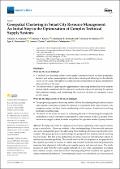| dc.contributor.author | Kapanski, A. A. | |
| dc.contributor.author | Klyuev, R. V. | |
| dc.contributor.author | Boltrushevich, A. E. | |
| dc.contributor.author | Sorokova, S. N. | |
| dc.contributor.author | Efremenkov, E. A. | |
| dc.contributor.author | Demin, A. Y. | |
| dc.contributor.author | Martyushev, N. V. | |
| dc.coverage.spatial | Basel | ru_RU |
| dc.date.accessioned | 2025-03-24T06:34:15Z | |
| dc.date.available | 2025-03-24T06:34:15Z | |
| dc.date.issued | 2025 | |
| dc.identifier.citation | Geospatial Clustering in Smart City Resource Management: An Initial Step in the Optimisation of Complex Technical Supply Systems / A. A. Kapanski, R. V. Klyuev, A. E. Boltrushevich [et al.] // Smart Cities. – 2025. –Vol. 8, Iss. 1. – P. 1–17. | ru_RU |
| dc.identifier.uri | https://elib.gstu.by/handle/220612/41197 | |
| dc.description.abstract | For large cities with developing infrastructures, optimising water supply systems
plays a crucial role. However, without a clear understanding of the network structure
and water consumption patterns, addressing these challenges becomes significantly more
complex. This paper proposes a methodology for geospatial data analysis aimed at solving
two key tasks. The first is the delineation of service zones for infrastructure objects to
enhance system manageability. The second involves the development of an approach for
the optimal placement of devices to collect and transmit hydraulic network parameters,
ensuring their alignment with both water supply sources and serviced areas. The study
focuses on data from the water supply network of a city with a population exceeding
half a million people, where hierarchical clustering using Ward’s method was applied to
analyse territorial distribution. Four territorial clusters were identified, each characterised
by unique attributes reflecting consumer concentration and water consumption volumes.
The cluster boundaries were compared with the existing service scheme of the system,
confirming their alignment with real infrastructure. The quality of clustering was further
evaluated using the silhouette coefficient, which validated the high accuracy and reliability
of the chosen approach. The paper demonstrates the effectiveness of cluster boundary
visualisation for assessing the uniform distribution of pressure sensors within the urban
water supply network. The results of the study show that integrating geographic data
with water consumption information not only facilitates effective infrastructure planning
and resource allocation but also lays the foundation for the digitalization of the hydraulic
network, a critical component of sustainable development in modern smart cities. | ru_RU |
| dc.language.iso | en | ru_RU |
| dc.publisher | MDPI | ru_RU |
| dc.subject | Spatial clustering | ru_RU |
| dc.subject | Optimisation | ru_RU |
| dc.subject | Geographic segmentation | ru_RU |
| dc.subject | Ward’s method | ru_RU |
| dc.subject | Water resource management | ru_RU |
| dc.subject | Silhouette quotient | ru_RU |
| dc.subject | Infrastructure planning | ru_RU |
| dc.title | Geospatial Clustering in Smart City Resource Management: An Initial Step in the Optimisation of Complex Technical Supply Systems | ru_RU |
| dc.type | Article | ru_RU |
